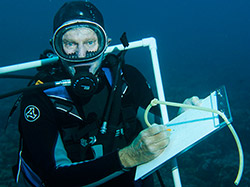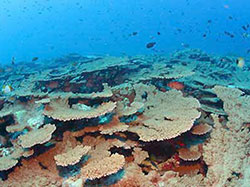Early NWHI Researcher Dies
Dr. Ricky Grigg, a pioneering big-wave surfer, University of Hawaiʻi marine biologist, and early researcher of the Northwestern Hawaiian Islands ( NWHI), died on May 21 in Honolulu at the age of 77.
In the late 1970s, Grigg was one of the first to recognize that the NWHI represented one of the last great unexplored wilderness areas. He oversaw what was known as the “Tripartite Studies,” a collaboration among the State of Hawaiʻi, U.S. Fish & Wildlife Service, and NOAA Fisheries that provided a framework for extensive ecological research in the NWHI. From October 1976 to September 1981, the agencies, along with the University of Hawaiʻi Sea Grant Program, surveyed the islands, banks, reefs, shelves, seamounts and overlying waters of the NWHI and amassed data on the various marine and land inhabitants. During this time, Grigg was the first to discover Acropora (table coral) at French Frigate Shoals, which were at the time thought to be absent in Hawaiian waters.
Two major symposia covering the Tripartite Studies research were held at the University of Hawaiʻi at Manoa in 1979 and 1983, the proceedings from which contain the results of more than 100 research projects. This effort constituted the first significant body of scientific exploration characterizing the NWHI. When the third major scientific symposium on the NWHI was held in 2004, Grigg was invited to be the keynote speaker.
Grigg’s research included the first forays into what are now known as mesophotic coral ecosystems, the deep coral reefs that lie beyond the reach of conventional SCUBA diving. These dives earned Grigg a reputation as a pioneer of deep diving, and resulted in significant discoveries on the biology of black coral (Antipathes spp.).
Originally an advocate of exploratory fishing and the development of new fisheries in the NWHI, Grigg later was a strong supporter of sanctuary designation and full protection for the region. The work he and other scientists did during the tripartite studies laid the groundwork for a level of understanding about the NWHI that eventually led to the process that culminated with the designation of Papahānaumokuākea Marine National Monument.
“Ricky was a great waterman and a great scientist,” says Randy Kosaki, deputy superintendent of field & research for Papahānaumokuākea Marine National Monument. “His contributions to our understanding of the NWHI set the bar high for all succeeding generations of marine scientists.”

